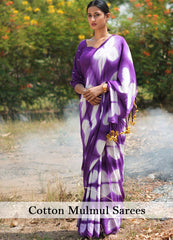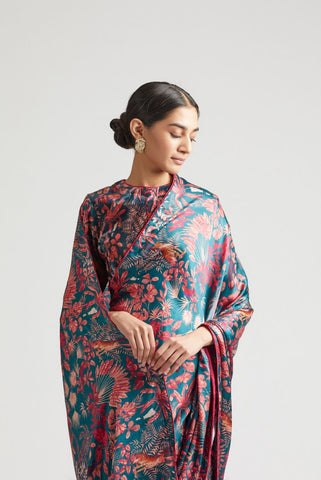
BLOSSOM HAPPINESS
Posted on December 09 2022
Let's make fashion breathable. The flower Blossom in the royal purple saree, makes it a easy, breezy ready to go saree. The pure cotton mulmul fabric, itself is a must keep in the wardrobe .Nothing says joy like flowers. They have this magical ability to light up a smile and dispel gloom. Like previous years, floral prints took center stage at various fashion shows. As we get ready to welcome spring, making our wardrobes lighter, it will be a good idea to add a few cheerful floral looks in our wardrobe. Few things spell happiness like flowers. Fashion designer, Nikiti Tandon, says, “Flowers add such delight to fashion! We absolutely need lots of florals in our wardrobe this season. After what we have been through in the past year, this is one trend that brings happiness. It’s a classic trend, and very easy to dress up and dress down.” It's rightly said that flowers pep up any look instantly and add the necessary amount of quirk. “We can say a lot with your outfit without having to layer up if we are wearing florals.” Floral prints also work beautifully when juxtaposed with other prints. “Oversized floral look great. You can pair them with solids. The best is to pick a color from the print itself or go with basics like nudes, blacks and washed denim.
To this day, we think of purple as the color of royalty and luxury. Consequently, it brings up a feeling of trust and reliability. Purple's rarity also gives it an air of mystery. It's associated with creativity and the realm of fantasy — think about how many times magic gets portrayed as purple in popular culture .When it comes in aspect to sarees, the game is in our hands. Fun, lighthearted -By celebrating vintage patterns in modern silhouettes, we create a refreshing look. “Presenting vintage patterns in a contemporary way in a fun way to wear florals. Team them with knee high boots, wear as one shoulder dresses, crop-top and co-Ord sets. Vintage floral dresses with English garden floral print, short sleeves, scoop neckline and fitted waistband at the back. Wear it right - If the print is quite elaborate and speaks for itself, keep them minimal. Also choose the print wisely. Lean body types can go for big floral prints, while petite builds can go for sparse prints and those on the heavier side can go for denser, smaller print as it gives a slimming effect. Darker backgrounds of florals work well for them.
Party-worthy -Florals make for heard turning looks for parties. Bold and big accessories can dilute the beauty of florals. So team florals with light and delicate jewelry like studs or a bracelet. A solid colored clutch goes well with floral. Less is more when it comes to styling with floral prints.
What do flowers represent in fashion?
Flowers have never been restricted to a particular sector or society; these nature's creations have had an indivisible role to play at auspicious occasions, celebrations, architecture, art, culture, and fashion. Floral motifs have been a symbol of purity, femininity, fertility and prosperity. From art to architecture and from metaphors to motifs, florals have been around for long, yet have unmatched importance throughout every culture. The beauty of these ingenious creations have been open to a copious amount of variations and interpretations through time – especially in fashion. Believed to be originated in the East, the floral print travelled to the West with traders that brought exquisite silk dresses with floral embroideries. The pattern was also paired with other elements of nature like leaves, birds, and animals. From prints to embroideries to jewelry, with a wide range of diversity, flowers come as naturally as breathing. Every period in history has had one floral motif as a highlight. While it began with peonies during the Tang dynasty period of 618-907 AD in China, floral laces took over only in the 16th century. As the floral print came over to Europe, the 16th and 17th century saw the up rise of tulips, pomegranates and Indian Chintz, which further were replaced by the lovely carnations in the 18th century. However, today's fashion has been able to incorporate technology with art. Various techniques like embroideries, 3-D embellishments, sequins and other uncommon materials create exquisite floral interpretations. As with colors, cultures worldwide have used flowers to symbolize their feelings, emotions and beliefs. Talking about the symbolic significance of the motif, fashion designer Kshitij Jailor said, "I believe florals were used on clothing for their symbolic values. Many such examples are present across cultures of particular florals being associated with the sun, chivalry, free spiritedness. The introduction of florals on clothing is bit sketchy, however, it does point towards a symbolic connection."

An unwavering source of inspiration
"There is nothing easy or difficult about design. It's how you perceive a particular element and define the same through your design language. Artworks deriving from florals could range right from the actual simplest shapes with the most minimal of applications to something as detailed as understanding the origination structure and designing an abstract artwork around the same," explained by Mr. Jailor.
There are about 400,000 different species of flowers on our planet with unimaginable hues and shades. The designer particularly relates a lot more with leaves and fauna than florals, a consequence of his preference towards perennials over seasonal. In 2020, the label presented three collections - Cinnamon Hill, The Garden Room and Saigon Central - where motifs like Traveler Palm/Ravenala, China Palm, Fan Palm, Banana Palm, Areca palm, Monstera, Chinese Money Plant, Rhaphis Palm, Fiddle Leaf Fig, Dracaena, and Frangipani were blended exceptionally with fauna elements like elephants, tigers, leopards, deer, monkeys, and birds like the Moluccan and Banksian Cockatoo, Eclectus parrot, toucan and hornbills. The designer further mentioned his upcoming plans with the motif for his latest collection: "We have used various floral elements across various design collections like the heavily ornate and detailed florals from Chintz for a collection called The Coromandel Colony or interpretations of Persian roses and flora in Gul Bulbul. Our upcoming collection focuses on florals in Mexican tropics like hibiscus, hydrangeas, anthuriums, etc." Devina Juneja, an Indian designer who uses sustainable leather, said, “Florals have a universal appeal. The variety and colors are endless and so are its applications in terms of pattern, embroidery, appliques and prints.” Ms. Juneja’s Flowers in Bloom cape sees florals represented by painstaking leather work, to create an overlay that can add charm, whether worn over a tank or a saree. The beauty of fashion is its nature of being subjective, relatable and abstract, all at the same time. Similarly, flowers have played and inspired different designers in a different light. While some made florals immortal due to their elegant beauty and femininity, others found the short life span of florals more endearing. The late British fashion designer, Alexander McQueen, used fresh flowers to make dresses for his Spring/Summer 2007 Sarabande collection. "I used flowers because they die," Mr. McQueen said to a magazine at that time. As his iconic dresses came down the runway one after the other, the collection became a representation of the fragility of life. It signified that nothing is permanent, and beauty disappears. Dichotomies such as beauty and decay, life and death, have been an underlying emotion in most of Mr. McQueen's work. The designer further created several designs using roses most eccentrically. The designer used burlap sacs, leather, and techniques like hand-painting, pin-tucking and gathering to create floral designs.




0 comments